When people think of beaches and Europe they immediately think of the rustic chic of the Greek Islands and the glitz and glamour of the French Riviera. But while these are undoubtedly stunning locales, they are only the beginning.
At Europe’s diverse beaches, you can swim in crystal-clear waters, dine overlooking an inactive volcano, mingle with Hollywood stars or do some stellar shopping. History buffs can catch the sun while exploring ancient archaeological sites. Night owls can drink and dance into the early hours of the morning, then wake up post lunch to work on their tan. And foodies are spoiled for choice no matter where they go.
You don’t have to blow your budget either — though if you’re after a once-in-a-lifetime luxury experience, you can get that too.
Not sure where to begin? We’ve rounded up the most fabulous beach towns all across Europe, including a few you may never have heard of. Don’t forget your sunscreen.
Biarritz, France
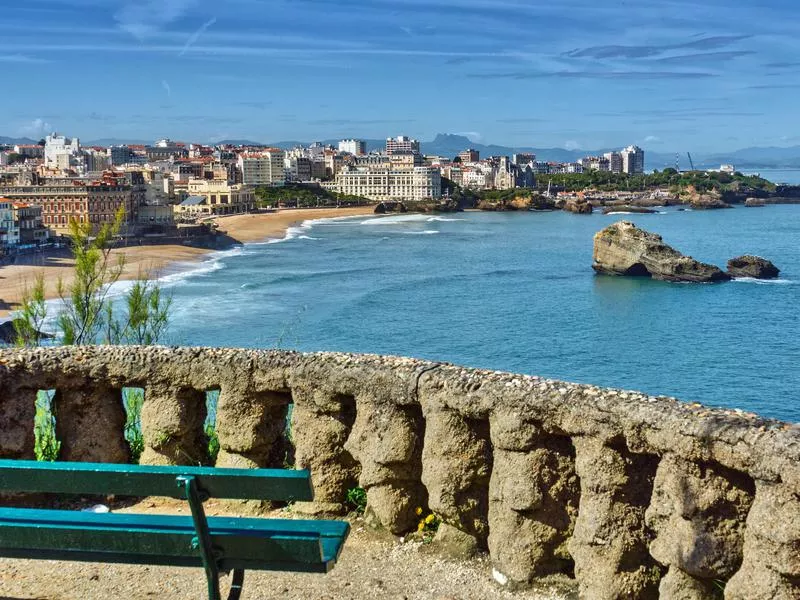
Families and surfers alike flock to Biarritz. Tree4Two / Getty Images
Biarritz has been a fashionable resort on France’s southwestern Basque coast since the 1800s, when Napoleon III frequently stayed in the 19th century Hôtel du Palais with his Spanish-born wife Eugénie.
Elegant villas and heritage-listed residences line the streets, along with several quality museums and even an Orthodox church. The Art Deco Casino Municipal marks the Grande Plage, the main town beach.
There are a total of 6 kilometers of beach in Biarritz, and wild waves are ubiquitous, making this spot popular with surfers. Easy access to the water, meanwhile, attracts the family crowd.
Between swims, visit the Rocher de la Vierge (Rock of the Virgin), a rocky outcrop topped with a statue of the Virgin Mary. Splurge on a drink in a bar with drop-dead gorgeous views over the Bay of Biscay, and sample Basque specialties in the covered Les Halles food market.
Brighton, England
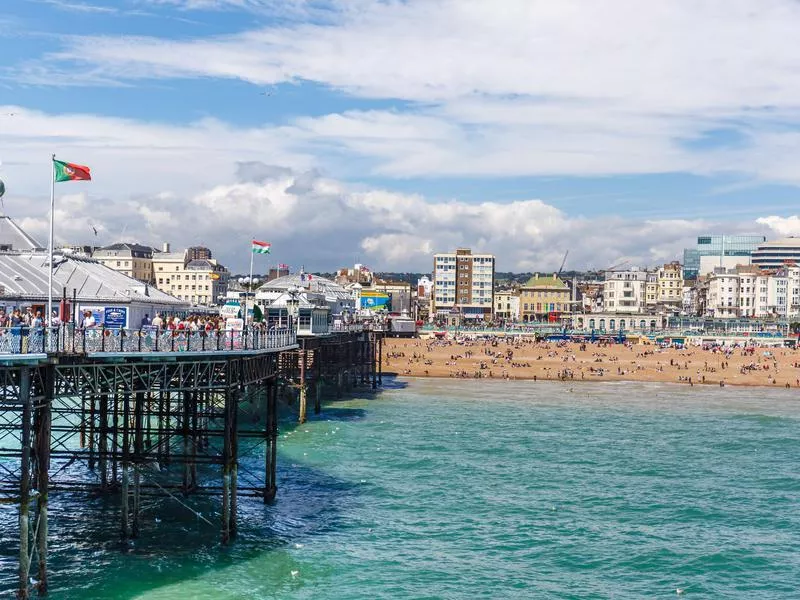
Historic Brighton still brims with British charm. Alexey_Fedoren / Getty Images
Brighton, on the south coast of England, historically welcomed men wearing trousers rolled up to their knees, knotted handkerchiefs on their heads, eating fish and chips from newspaper. Today, the beach attracts sun-seekers with its colorful deck chairs, and it’s always great fun to tread the boards of the iconic Brighton Palace Pier.
When it gets really hot, take a ride on the Volks Railway or dip your toe in the water. Quaint Dukes Lane is perfect for serious big-name shopping, and vintage fashionistas will think they’re in heaven.
Traditionalists can still dine on fish and chips, either on the beach or in a more upmarket setting, while hipsters, gourmet diners and even tea lovers are well-catered for.
The town of Hove, famous for its colourful beach huts, is a short walk from the city center. Rottingdean, a picture-perfect English village, is a brisk walk past the Brighton Marina in the other direction.
Ericeira, Portugal
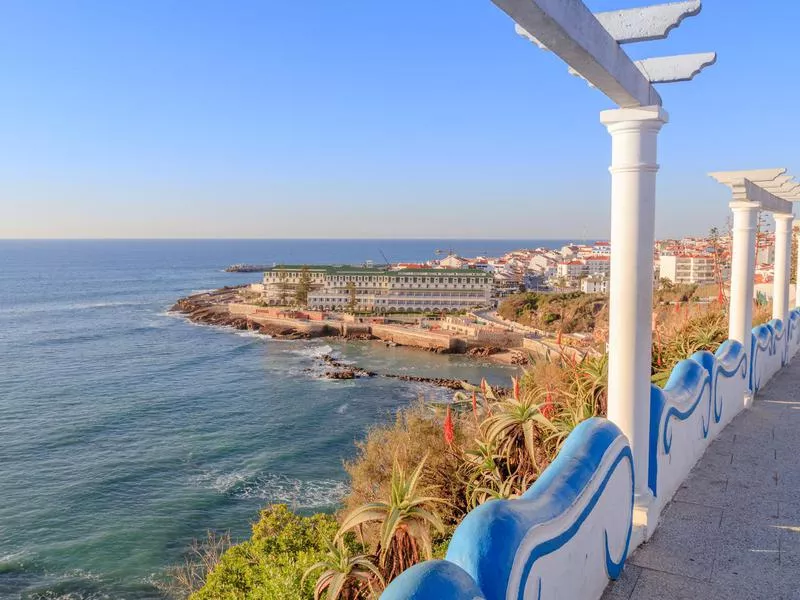
Step back in time in charming Ericeira. Americo Lopes / Getty Images
Ericeira, a seaside town near Lisbon, feels unchanged from centuries ago. Streets of whitewashed houses, their windows picked out in bright blue, lead to the compact main square, Praça da República. Old men sit under architecturally manicured trees before lunching in one of the many cafes, restaurants and bars.
Ericeira was the fourth largest commercial port in the country in the 19th century, and there’s still a local fishing fleet bobbing in the harbor. There are an impressive number of beaches to choose from, all popular with surfers. Beginners need not fear, though, as there are plenty of surf schools.
Those seeking a more sedate day in the sun can head for Fisherman’s Beach. Known locally as Praia dos Pescadores, it’s where King Manuel II set sail for Brazil, fleeing the 5 October Revolution in 1910. At night, residents and visitors come together in local restaurants to feast off percebes, tamboril and other exotic seafood.
Kas, Turkey
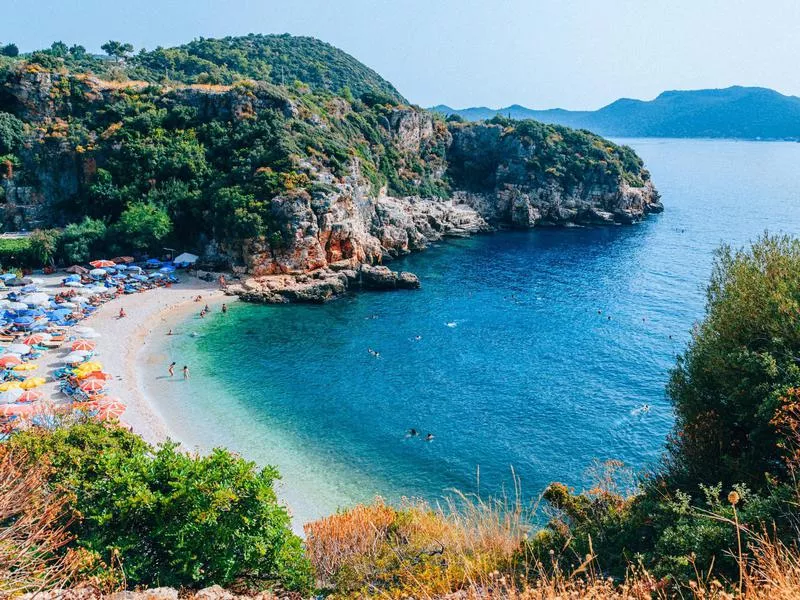
Natural beauty and intriguing history meet in Kas. serts / Getty Images
It’s long been debated whether Turkey is Middle Eastern or European. One visit to Kas, on the Mediterranean coast, will confirm it’s definitely part of Europe.
Greeks and Romans fought over this town, but it’s the Lycians who left the most historical remains. Lycian tombs are tucked high in rugged mountains, and ancient sarcophagi sit in the middle of the road or submerged in shallow waters.
The high salt content of the water makes swimming easy, and the fish-filled bays are a magnet for scuba divers. Small boats travel between the compact harbor and secluded bays perfect for sunbathing. Larger boats offer daily excursions that take in an underwater city, Simena, destroyed by earthquake in the second century.
Valencia, Spain

Valencia is known for its spectacular cultural sights. But its beaches, like La Malvarrosa, are enticing too. Boris Dzhingarov / flickr
Valencia, on Spain’s Mediterranean coast, dates back to the year 138 BC, yet it’s very much in the present. Historical buildings compete with avante-garde features, small backstreets offer new takes on ancient rites, and long, clean sandy beaches are timeless in their beauty.
Barrio del Carmen in the Old Town is packed with narrow alleys lined with old mansions, tapas restaurants, and terraces blending Roman and Arabic influences. The Palace of the Marqués de Dos Aguas boasts a surreal mix of Rococo, neo-Classical and Oriental architectural styles.
It’s in delicious contrast to the futuristic riverside architecture in The City of Arts and Sciences.
Mix sightseeing with lazing on a sun lounger at nearby La Malvarrosa beach. After a day spent enjoying the fine sand and clean water, dine at one of the many restaurants lining the beach. Don’t forget to try the paella; it was created in Valencia, so it’s sure to be good.
Kotor, Montenegro
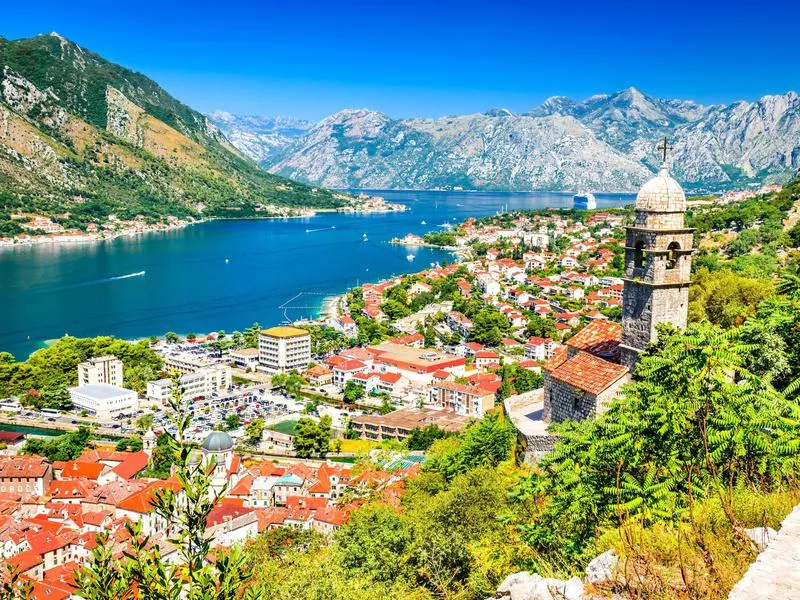
When not lounging on the beach, visitors enjoy Kotor's fascinating Old Town. emicristea / Getty Images
Dark mountains tower over Kotor, reflected in the mirror-like water of the bay, providing a surreal backdrop for two islets. The most interesting, Gospa od Skrpjela (Our Lady of the Rocks), was created when local fishermen carried large stones out to the middle of the bay in their boats. A church was built on top to house a holy icon discovered in a shipwreck.
The Medieval Old Town has winding streets, minute squares, churches from the 12th to 15th centuries, and countless boutique shops selling jewelry, antiques and more. Kotor has the only completely preserved fortifications in the Mediterranean, and three huge gates allow access, all of them leading to the sublime 7th century Cathedral of Saint Tryphon (Sveti Tripun).
Swim at stony beaches or dive in anywhere around the bay. Restaurants built out over the water offer a welcome respite from the sun for a leisurely lunch or early evening drink and dinner.
Lerici, Italy
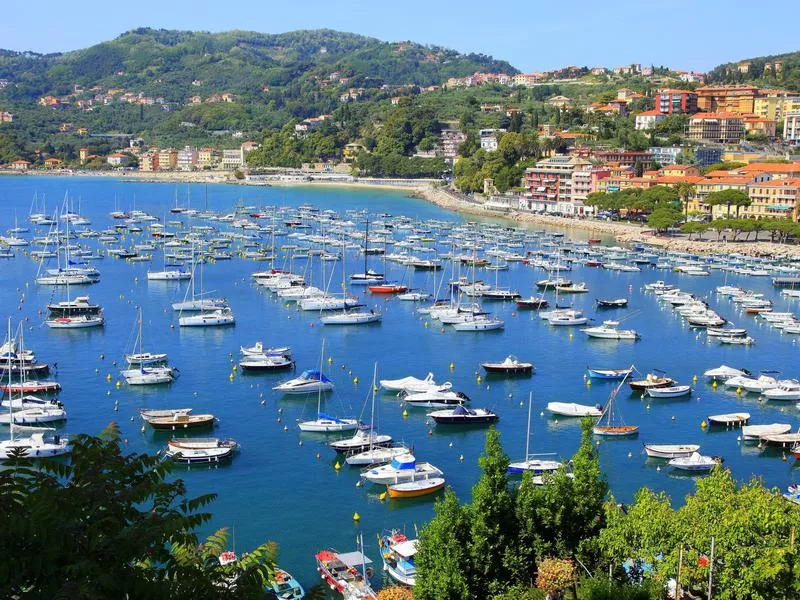
Among a collection of magnificent harbor villages, Lerici stands out. agustavop / Getty Images
Visitors to Cinque Terre, the picturesque harbor villages lining Italy’s Ligurian coast, often base themselves in La Spezia. However, a short bus ride east leads to Lerici, a small beach town well worth a visit. The nicest approach is to get off the bus just past San Terenzo. A gentle coastal path bordered by lush green hills on one side and sparkling turquoise water on the other winds around the bay.
Founded by the Etruscans, the rule of Lerici was much contested. Genoa and Pisa dueled over it for decades, it became part of the First French Empire, then the Sardinian Kingdom, before being merged into Italy.
Today the only battles being fought are over which stretch of sandy beach is best. There’s a local market every Saturday featuring live music and craft stalls selling handmade souvenirs. Grab lunch in Piazza Garibaldi before tackling the 360 steps to the medieval castle. Or take the lift.
Marbella, Spain
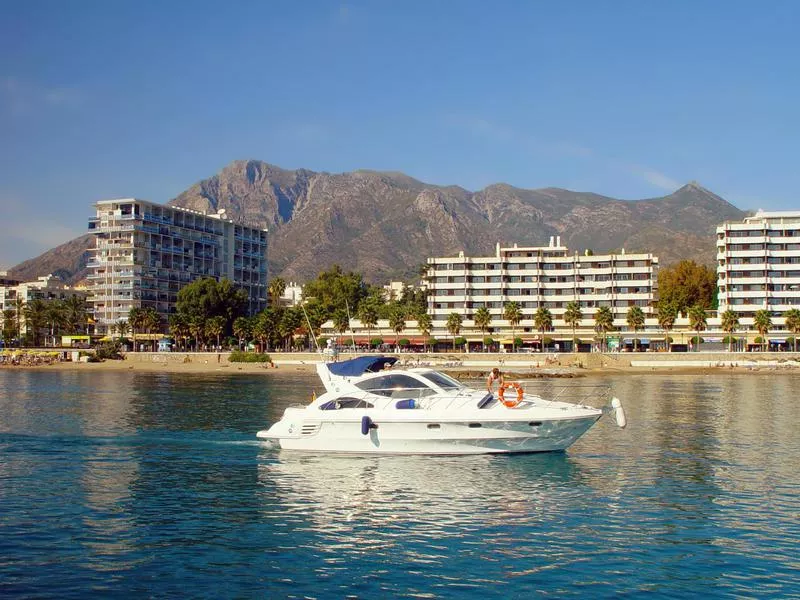
The rich and famous flock to Marbella. WillSelarep / Getty Images
Located in the province of Malaga in the famous Costa del Sol region, Marbella is known as the playground of the rich and famous. Wealthy gato (Madrid locals) and international actors keep summer homes here, the streets are lined with designer boutiques, and there are 15 impressive beaches to choose from.
Yet Marbella has plenty of history and culture on offer too. The Old Town, Casco Antiguo, is centred around Plaza de los Naranjos, named for the many orange trees that fill the square. 9th century castle walls built by the Moors lead to a Baroque church holding 12th century frescos.
The Marbella Golden Mile is a picturesque bike ride leading to Puerto Banus Harbour. Once there, inspect the super yachts or admire superb mosaics housed in a Roman villa built in 200 AD.
Back in Marbella, marvel at 10 bronze statues designed by Salvador Dali located along Avenida del Mar before heading to Marbella Beach for a seafood dinner.
Piran, Slovenia
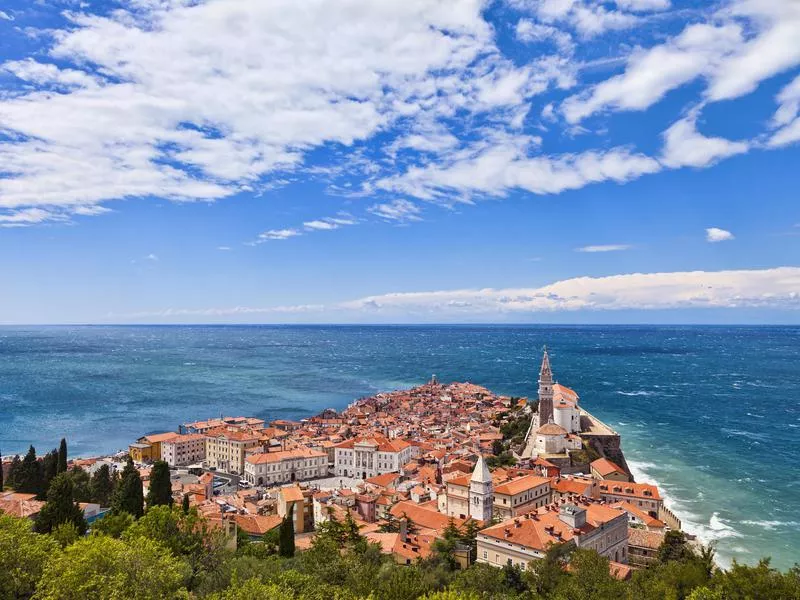
A beach town in Slovenia? Yep. And it's stunning. piranka / Getty Images
Piran, set on a long narrow peninsula jutting out into the Adriatic Sea, comes as a surprise in a country better known for its forests, mountains and lakes. But it’s a must-visit in its own right.
Small and well-preserved, Piran was once part of the seafaring principality of Venice. Tartinijev Trg (Tartini Square) is notable for its elegant 15th century Venetian merchant house and a statue of Piran’s most famous man, Giuseppe Tartini, a composer and virtuoso violinist.
There’s also a grand church whose chiming bells come in handy for finding the way out of the maze of narrow backstreets. These hide intriguing ceramic and painting galleries, tiny cafes, regional museums and shops.
There are no sandy beaches in Piran so locals spread out on the rocks lining the seafront walk. Regular bus services run up and down the coast, making it easy to explore the surrounding towns.
Rethymno, Crete, Greece
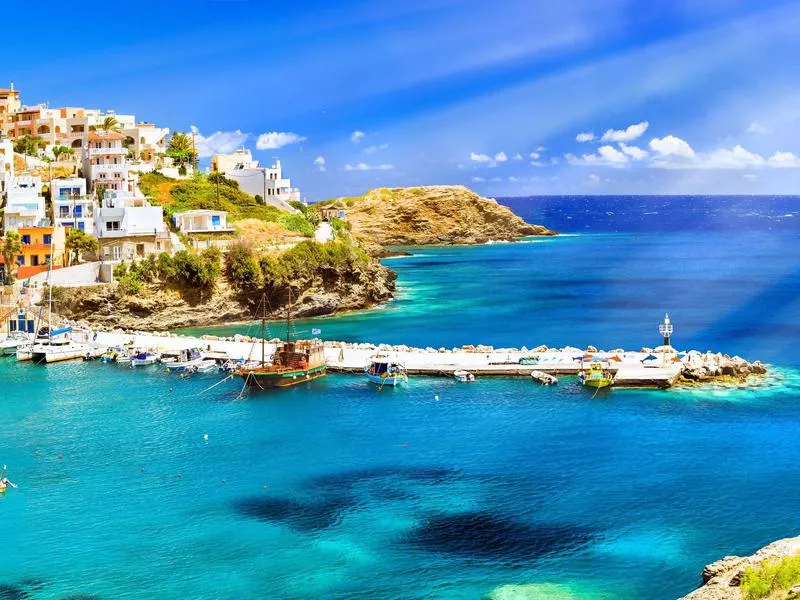
History fiends will love this town as much as sunbathers do. chasdesign / Getty Images
Rethymno’s streets are a pathway through history, as the Italians and the Turks both ruled here at one time.
The picture-perfect harbor looks like a movie set with its low sandstone textured buildings set around a small bay, their colors reflected in the jewel-blue sea and sky. The 16th century fortress is testament to Venetian glory, but the Turks came in the 17th century and left their own legacy.
Two mosques, the Neratze and Kaar Musa Pasa, remain from this once powerful empire. Greek history is in abundance too. Narrow streets lead to Orthodox and Catholic churches with deceptively simple exteriors hiding extravagant interior designs. Local shops offer an incredible array of Cretan food products and there’s a weekly laiki — an open-air street market — and spectacular wine tasting rooms.
North and south of the town center, more than a dozen sandy white beaches are a short drive away.
San Sebastian, Spain
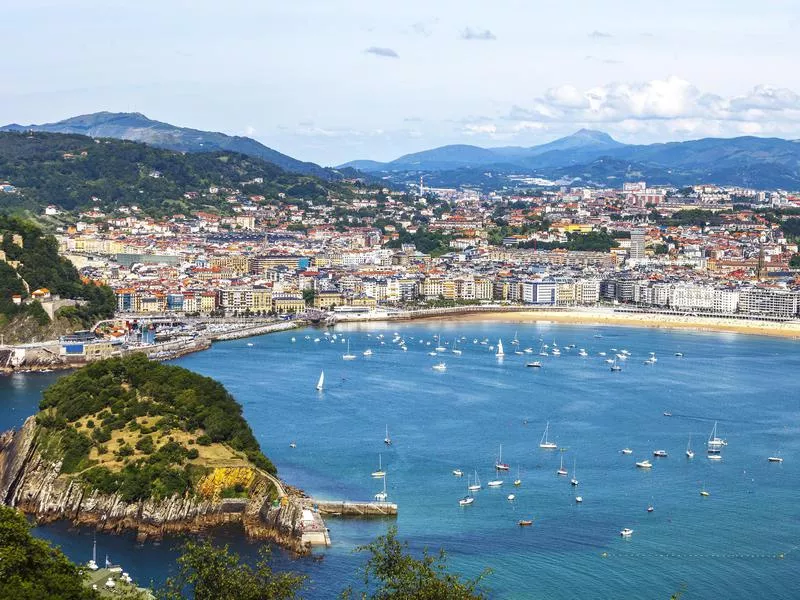
Those looking for a good time head to bustling San Sebastian. peeterv / Getty Images
Set in the Basque region of northern Spain, San Sebastian has two beaches, four annual film festivals, open-air art, museums, galleries, and enough bars and restaurants to keep even the fussiest eater happy.
By day, discover the carefully laid out Belle Époque Romantic architecture, and ancient churches and basilicas. In the evening, graze the bars in the Old Town for the best pintxo (Basque for “small snack”) pared with a glass of Spanish wine. After a late night, the more sheltered Concha Bay is great for sunbaking, paddling and cooling off.
The more open Zurriola beach has waves made for surfing — body or board — as well as volleyball, football and beach tennis. It’s overlooked by the Kursaal Congress Centre and Auditorium. This somewhat architecturally forbidding building is the center of San Sebastian’s vibrant and busy cultural calendar. It’d be hard to find another beach town with more going on than San Sebastian.
San Teodoro, Sardinia, Italy
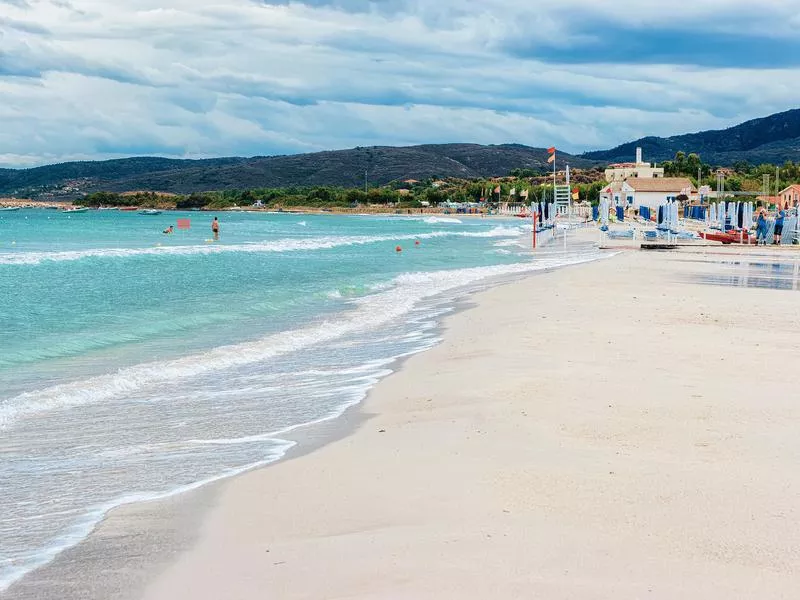
In San Teodoro, it's all about sunny days and late nights. RomanBabakin / Getty Images
Seeing a pink flamingo isn’t always the result of drinking too many cocktails. Stagno di San Teodoro lagoon, rich in flora and fauna, is where the fanciful birds rest during their migration. The lagoon is located in San Teodoro, a town known locally as Santu Diàdoru.
Be sure to nap before going out for the night in this bustling locale. In San Teodoro, nobody dines before eight and the clubs are empty until midnight. Start at one of the laid-back bars in lush poolside garden settings before heading out. Dress to match the elegant interiors and fashionable clientele, and enjoy the dance-ready playlists.
The small island of Tavolara, a limestone massif once proclaimed the world’s smallest kingdom, is a short boat ride away from town. And keep in mind that the coast of Sardinia is studded with dense Mediterranean scrub leading to impossibly dazzling beaches, of which San Teodoro is only one. There's also the aquamarine shades of Isuledda, the tropical colored waters of Lu Impostu and the silky white sands of La Cinta.
Saint-Tropez, France
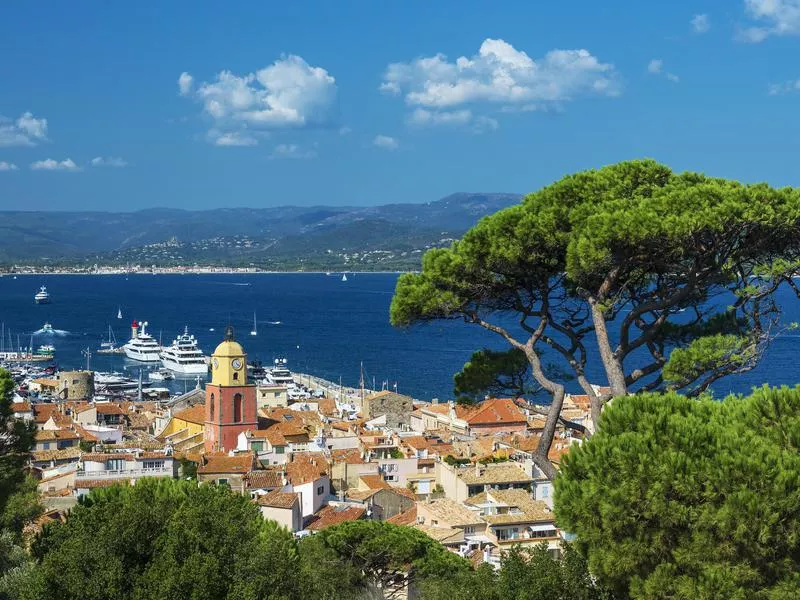
Beautiful people see beautiful sights in Saint-Tropez. andrzej63 / Getty Images
The name Saint-Tropez conjures up images of glittering nightlife, elegant restaurants full of beautiful people, and glamorous women like Brigitte Bardot in impossibly tiny bikinis.
Once a small fishing village, Saint-Tropez now has more millionaire super-yachts in its Vieux Port (Old Port) than fishing boats. Yet the town has maintained its charm. Stroll through the cobblestoned La Ponche quarter, swim at one of the three small beaches nestled along a coastal path, or watch old men playing pétanque under the trees.
Early mornings, see locals on their way to shop at the market cross paths with A-listers on their way home. The sapphire blue sea and the glistening cobblestones are mesmerising, and it’s easy to see why artists such as Signac and Picasso flocked here to catch the light.
Sperlonga, Lazio, Italy
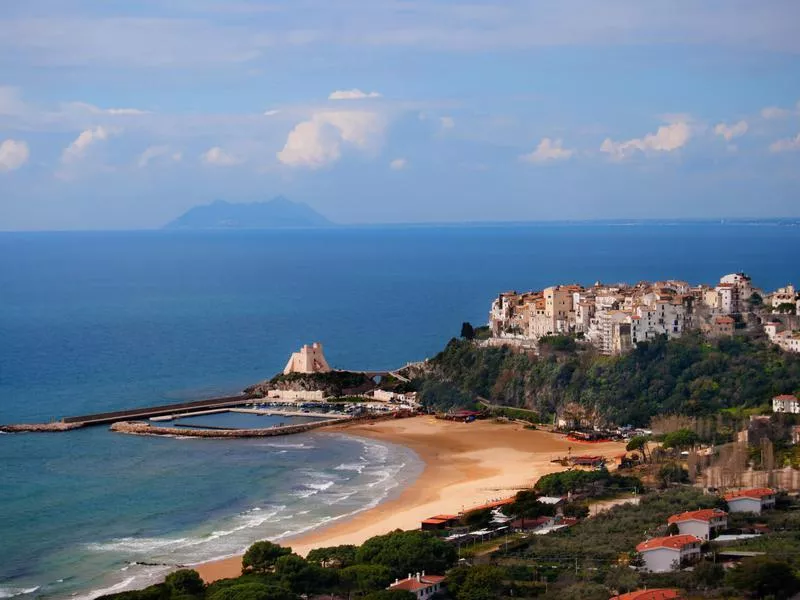
This forgotten stunner deserves to be rediscovered. irabassi / Getty Images
In the vertical village of Sperlonga, minute white houses are seemingly stacked precariously, one atop the other. Above them is sky and below them is the gleaming crystal-blue Tyrrhenian Sea. Once the summer hideaway of international movie stars such as Sophia Loren, as well as famous writers including Arthur Miller and Albert Camus, today Sperlonga is a forgotten gem.
Back in Roman times, Emperor Tiberius, who reigned from 14 to 37 AD, was the first to use it as a summer retreat. The ruins of his massive villa built into and over a grotto can still be visited. This grotto or cave, called spelunca in Latin, gives the town its name.
After a day spent on one of the two town beaches, or snorkeling in ancient Roman ruins, head back up to the main square for an aperitif while watching the sun go down. Dine on iella, stuffed pizza, or freshly caught seafood.
Alicante, Spain
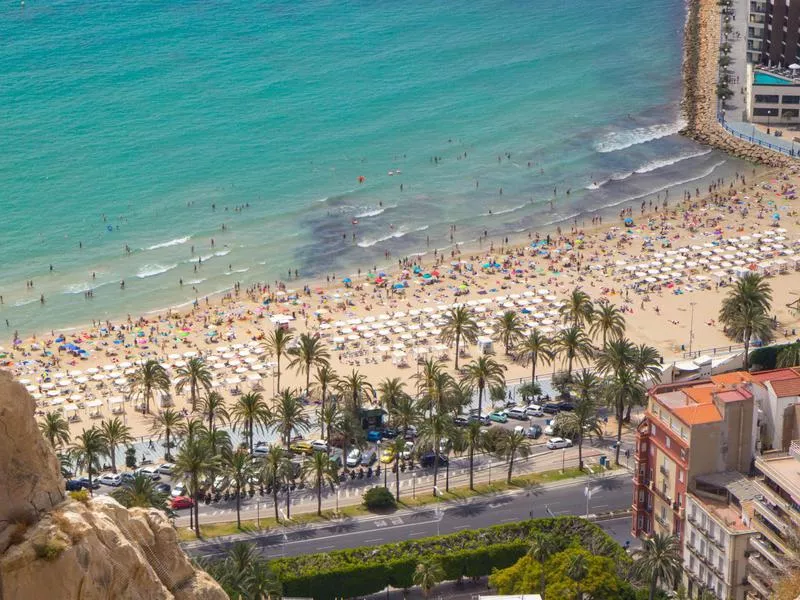
Postiguet beach combines sandy shores with fascinating history. Bet_Noire / Getty Images
Alicante’s mix of history, flat beaches and energetic nightlife make it a quintessential beach town. The old city houses the Gothic-style Santa Maria Basilica, Spain’s oldest active church; the Alicante Contemporary Art Museum, housed in a circa-1685 Baroque building; and a bomb shelter from the Spanish Civil War.
More into shopping than history? Choose from traditional leather goods like shoes and bags or homewares such as wickerwork and pottery at an assortment of high-quality outposts.
There’s more than half a dozen beaches to choose from, in or very close to town. All of them have restaurants and bars, and disability access during the summer. Playa de Aguamarga is dog friendly, and at Postiguet, an elevator ascends 544 feet to the medieval Castillo de Santa Bárbara.
Alaçati - Çesme, Turkey
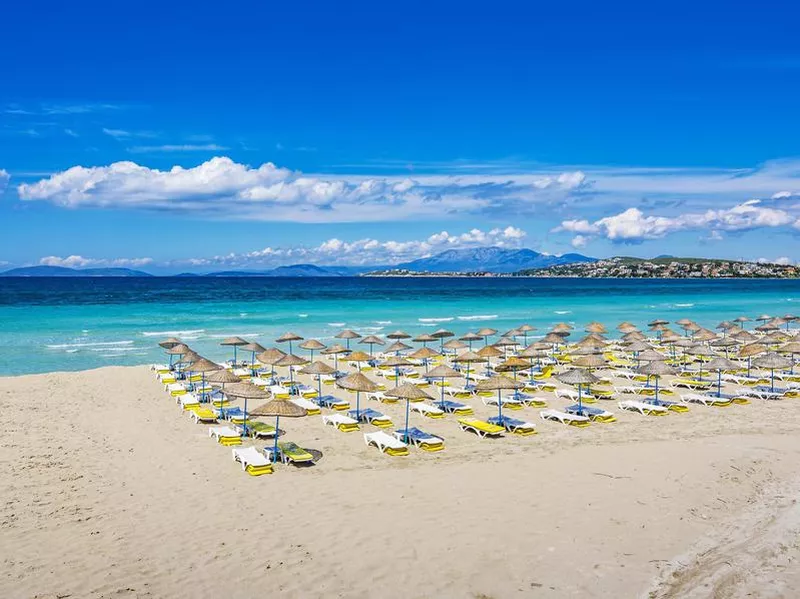
Dazzling Ilica Beach is ideal for resting between long nights of partying. nejdetduzen / Getty Images
Located on the Çesme Peninsula, 55 miles from Izmir on Turkey’s west coast, Alaçati was once a small village inhabited by Rum people, Turkish-born Greeks. Nearby Alaçati Beach, featuring the renowned Port Alaçati Marina water sport center, is famous for windsurfing — but no one really goes to Alaçati just to swim.
The place to go in Turkey in the summer, Alaçati is packed with delightful boutique hotels draped in grapevines, fine-dining establishments serving fresh local produce and fish, laid-back ultra chic bars, and an alluring contingent of the country’s rich and famous “beautiful” people.
History buffs can visit the 16th-century Çesme Castle with its small but interesting array of artifacts. Otherwise, most people choose to siesta or sunbake at Ilica Beach during daylight hours, recharging and getting ready for another night of socializing.
Ardmore – Waterford, Ireland
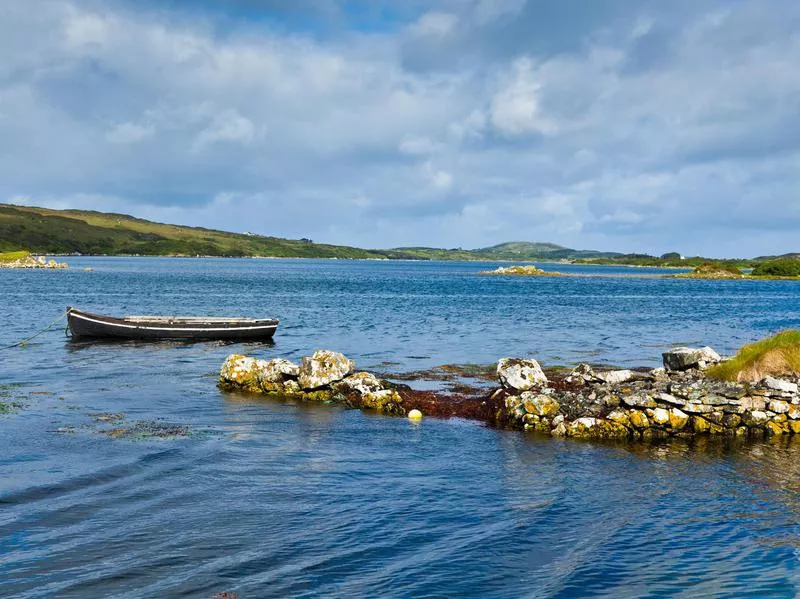
Ardmore typifies Ireland's distinctive beauty. igabriela / Getty Images
Ardmore, on Ireland’s south coast, is a typical beachside fishing village marked by compelling history and ample things to do, including swimming, walking and just winding down in a beautiful setting.
Walk from the town along the cliffs to the house of the same name. Along the way you’ll see the well-preserved ruins of a cathedral and an early Christian well, believed to be the remnants of Ireland’s oldest Christian settlement. Out to sea, a derelict ship lies marooned on the rocks, and if you’re lucky you’ll see a pod of dolphins passing by.
With a palette of emerald green tablelands, golden sands and white foam caps, nature has colored Ardmore’s beach in the image of the Irish flag. Depending on the weather, go for a swim or paddle. Dine on hearty Irish fare or contemporary seafood, either in the village or over in Youghal, five miles away.
Calvi – Corsica, France
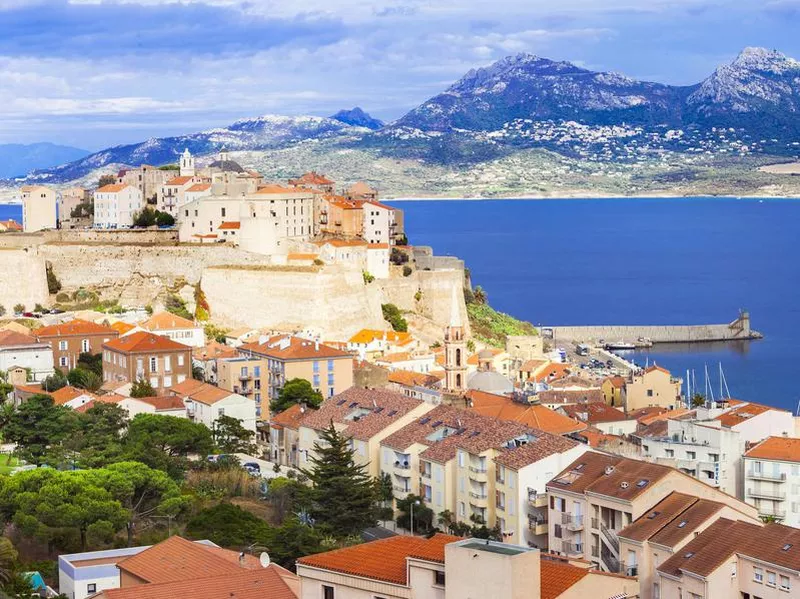
Some believe one of the world's most well-known explorers was born in this picturesque seaside town. Freeartist / Getty Images
Calvi, on the northwest coast of Corsica, is set around a crescent-shaped bay. Snow-covered mountains tower at one end while the town’s medieval Genoese citadel marks the other. In between is this gorgeous little town, full of Corsican history, food and culture.
In Santa Maria square, admire the pastel-colored church it’s named for. Enjoy a quick cup of coffee and ponder the legend of Christopher Columbus, who locals claim was actually born here, not Genoa, Italy. Seek out the 13th-century St-Jean Baptiste Cathedral, then stock up on wine, cheese and olive oil produced in the nearby Balangne mountain villages. Head along the cobbled streets to the glittering blue bay and meander along Quai Landry past the marina.
Or simply head for the beach. Calvi’s narrow, nearly five-mile stretch of white sand flanked by calm shallow water is the perfect location for swimming, kayaking or windsurfing.
Cassis - Marseille, France
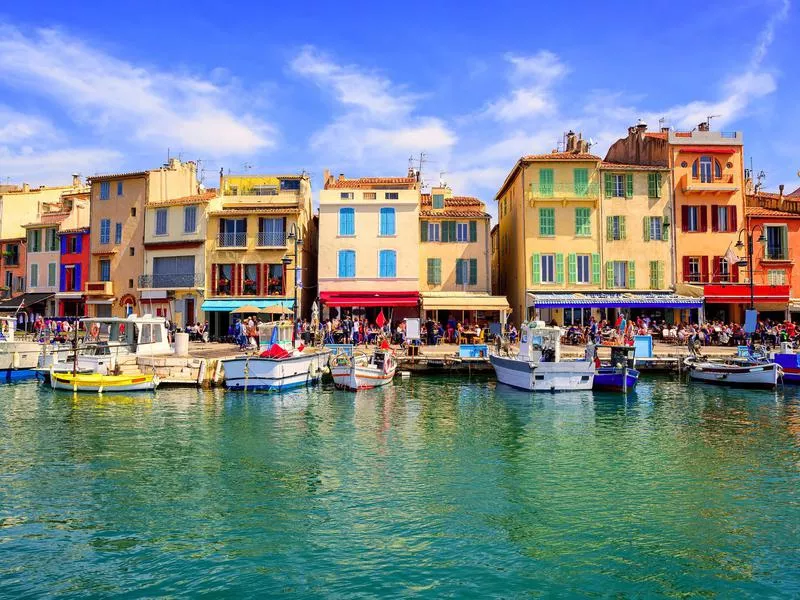
Colorful buildings make a statement in Cassis. Xantana / Getty Images
Cassis, near Marseille, is classic French Riviera. A tiny Mediterranean fishing port, it’s surrounded by vineyards that produce tangy fresh rosé and white wines. Browse in designer fashion stores with aspirational prices or pick up affordable local produce, like soap and cheese, at the Wednesday and Friday farmers’ market. Sunbake on small stretches of pebbles and swim in impossibly clear blue water, set among colored-stone buildings and hilltop bouquets of architecturally sculpted trees.
Limestone cliffs amp up the intensity of the turquoise water in small inlets known as calanques, often best reached by boat. Watch as the rays of the sun turn Cap Canaille, the highest sea cliff in Europe, into an extra-terrestrial wonder of color. Then dine under the awnings at one of the bars and restaurants in the harborside buildings.
For a special occasion, splurge at La Villa Madie, a Michelin-starred restaurant, to swoon at both the food and the view.
Polzeath – Cornwall, England
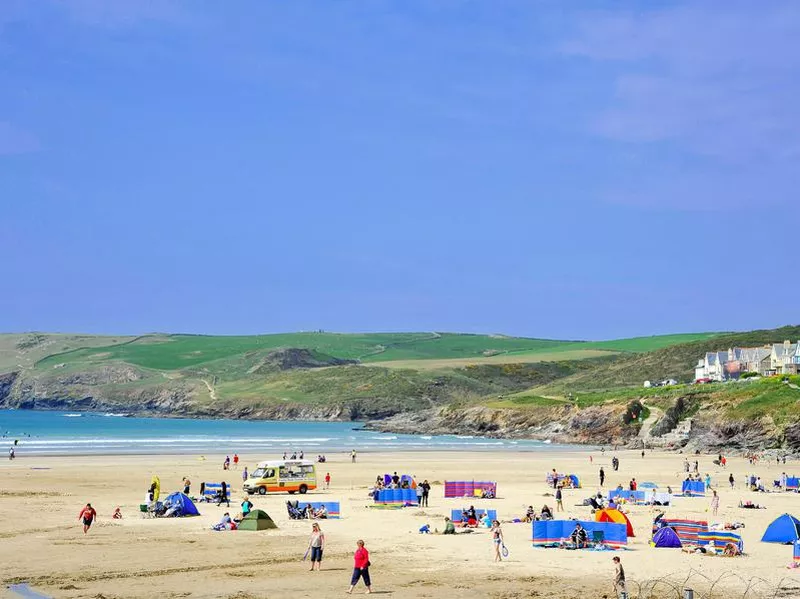
It's easy to see why Princess Diana was a fan of this idyllic beach town. clubfoto / Getty Images
With a stretch of honey-gold sand backed by tree-covered green hills, Polzeath on the north coast of Cornwall looks like an oasis of ocean calm. It was a favorite of the late Princess Diana, and with its large surf, is popular with board riders. Think Darcy in a wetsuit, conquering the waves before parading along the beach. One note of caution though: The current can be a tad rough at times, so it’s patrolled throughout the summer.
Polzeath is also a nature reserve. Dolphins sometimes mingle with surfers, while puffins and other birds at times lay claim to the coastal pathways. A gentle ramble leads to the 12th-century St Enodoc Church and the grave of Poet Laureate Sir John Betjeman. If all that sea air whets your appetite, head to a waterfront restaurant and tuck into a huge bowl of steamed fresh mussels or locally sourced lobster and crab. Sundrenched and sated, fall asleep to the sound of the waves.
Sirolo – Le Marche, Italy
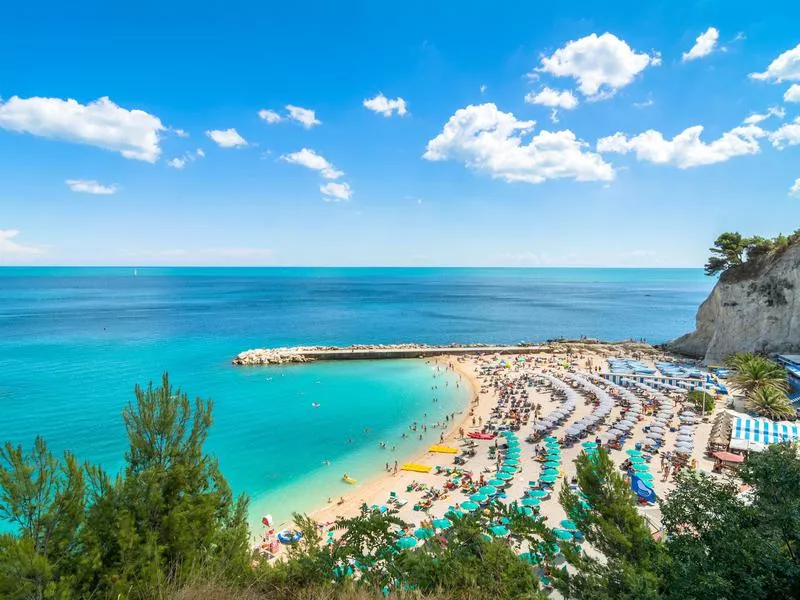
Sirolo is packed with appealing beaches for lazing about. eddygaleotti / Getty Images
The town of Sirolo, in the Marche region of eastern Italy, was once a medieval castle complex belonging to a single family. These days, the tiny streets and beautifully restored buildings are inhabited by those lucky enough to call Sirolo home.
From the town square, it’s possible to see Monte Cristo, a huge piece of limestone that erupts out of the Adriatic as if it’s just been dropped from the sky. The sheer white slopes meet the crystal sea along the coast like clouds suspended in the heavens.
There are seven beaches to choose from here. Most are easy to access, such as Urbani and Sassi Neri. Urbani is popular with Italian families who want to bake in the sun or scrunch their feet in the grey pebbles as they stand knee deep in the water. Sassi Neri is ideal for swimming and snorkeling.
Sopot – Poland

Heading to Poland? Add beach-going to your itinerary. Avalon_Studio / Getty Images
Until recently, Poland was better known for Chopin, vodka and pierogi (dumplings filled with meat or vegetables) than for its beaches. Thanks to Sopot, this is changing.
Poland’s major sea resort began life as a sleepy 13th-century fishing village but became popular in 1823, when Jean Georges Haffner promoted the benefits of sea-bathing. The town’s numerous mineral springs gave rise to a health-spa industry in the 20th century, of the Soviet rather than Kardashian style.
These days the concrete bunker esthete has been replaced by Baltic glitz and sparkle. People swim or walk to the end of Europe’s longest wooden pier or gaze in confusion at the Crooked House, so named because it is, on the main street Monte Cassino. The lush tree-lined seafront boasts an array of wooden bars that become music venues at night.
And yes, you can definitely find pierogi in Sopot, usually accompanied by an Aperol spritz.
St-Martin-de-Ré - Ile de Ré, France

St-Martin-de-Ré is ideal for biking and exploring. Petegar / Getty Images
If the idea of getting shipwrecked on an island appeals, except for the lack of creature comforts, then St-Martin-de-Ré on the island of Ré is the place to go.
The town was once entirely contained inside the 17th-century star-shaped fortifications designed by Vauban. Down by the water, the quay at St Martin is now full of harbour-side cafés, while the surrounding streets tempt with chic French antique shops, cute homewares and luxury brand names.
The island is largely flat, so rent a bike and start exploring. Cycle through fields of grapes and corn to the ancient fishing locks at Sainte-Marie-de-Ré or to the lighthouse at Plage de la Conche des Baleines. Stretch out on the white sand and daydream as the waves roll in off the Atlantic.
Back in town, learn more about the history of the island and its inhabitants in the Ernest Cognacq and Platin Museums.
Trogir - Croatia

In Trogir, striking architecture meets the sea. emicristea / Getty Images
The deep green of the Adriatic waters are a dreamy blue in the old harbor of Trogir, on Croatia’s central Dalmatian coast. Creamy-stone city walls, topped in places by red-tiled roofs, are reflected in mirror image on the sea.
This tiny island, linked to the mainland by bridges via the bigger island island of ?iovo, has been perfectly preserved. Buildings in Renaissance, Baroque and Romanesque architectural styles compete for attention, deservedly earning the town a World Heritage listing in 1997.
The 13th-century St Lawrence Cathedral houses the Renaissance Chapel of St John. Small cobblestone laneways duck in and out of the shade, leading to the harbor. Cool off at nearby Pantan beach or take a taxi boat to Okruj Gornji, a popular beach just over one mile long. When the sun goes down, eat at one of the beachside restaurants there, or head back to town and promenade along the harbor with the locals.
Whitby – Yorkshire, England
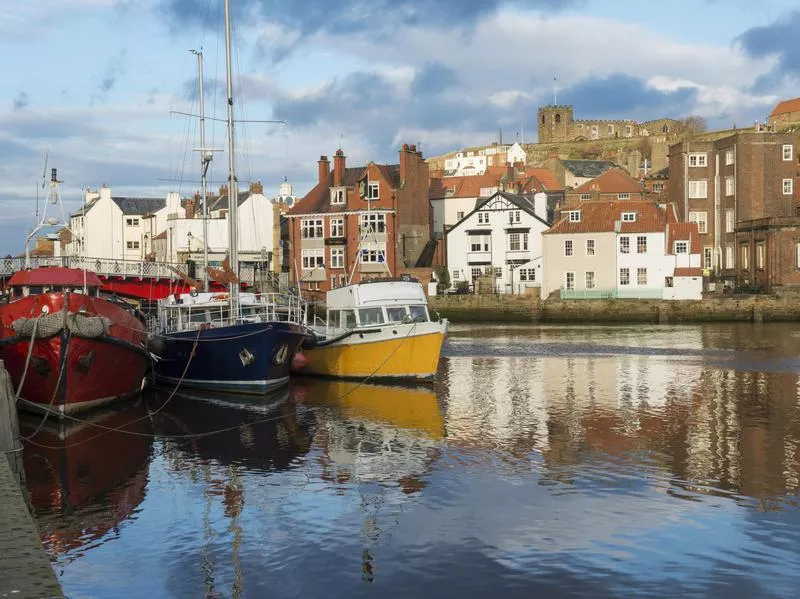
It's hard to beat the history in Whitby. richjem / Getty Images
On the surface, Whitby, on the east coast of England, looks like your typically quaint Yorkshire beach town. Three- and four-story brick terraces line the banks of the River Elk all the way to the sea mouth, white fishing boats bob up and down with the tide, and the streets are full of shoppers stopping to buy local produce and have a bite to eat.
However, up on the East Cliff, the brooding remains of Whitby Abbey are a reminder of darker times. Believed to be Bram Stoker’s inspiration for Dracula, Gothic details and mouldings imbue this 13th-century monastery with a sense of mystery.
Captain Cook, who made early European contact with Australia and the Hawaiian islands, also lived in Whitby. A memorial museum displays painting, maps and other artifacts related to his explorations.
Beach lovers will adore the brightly painted bathing huts lining the boardwalk at West Cliff Beach, while surfers favor the waves.
